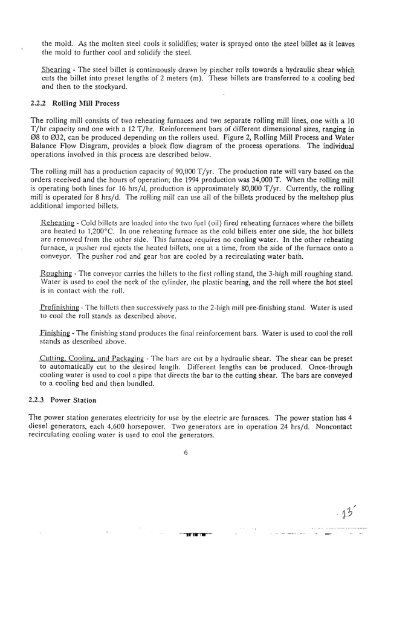Watcr Q!!alit\1 lmprovcmct1t at1() COf1scrvatiof1l'rojcct
Watcr Q!!alit\1 lmprovcmct1t at1() COf1scrvatiof1l'rojcct
Watcr Q!!alit\1 lmprovcmct1t at1() COf1scrvatiof1l'rojcct
You also want an ePaper? Increase the reach of your titles
YUMPU automatically turns print PDFs into web optimized ePapers that Google loves.
the mold. As the molten steel cools it solidifies; water is sprayed onto the steel billet as it leaves<br />
the mold to further cool and solidify the steel.<br />
Shearing - The steel billet is continuously drawn by pincher rolls towards a hydraulic shear which<br />
cuts the billet into preset lengths of 2 meters (01). These billets are transferred to a cooling bed<br />
and then to the stockyard.<br />
2.2.2 RoIling Mill Process<br />
The rolling mill consists of two reheating furnaces and two separate rolling mill lines, one with a 10<br />
T/hr capacity and one with a 12 T/hr. Reinforcement bars of different dimensional sizes, ranging in<br />
08 to 032, can be produced depending on the rollers used. Figure 2, Rolling Mill Process and Water<br />
Balance Flow Diagram, provides a block flow diagram of the process operations. The individual<br />
operations involved in this process are described below.<br />
The rolling mill has a production capacity of 90,000 T /yr. The production rate will vary based on the<br />
orders received and the hours of operation; the 1994 production was 34,000 T. When the rolling mill<br />
is operating both lines for 16 hrs/d, production is approximately 80,000 T /yr. Currently, the rolling<br />
mill is operated for 8 hrs/d. TIle rolling mill can use all of the billets ~roduced by the meltshop plus<br />
additional imported billets.<br />
Reheating - Cold billets arc loat.!et.! into the two fuel (oil) fired reheating furnaces where the billets<br />
are heatet.! to 1,200°C. In one reheating furnace as the cold billets enter one side, the hot billets<br />
are removed from the other sit.!e. llJis furnace requires no cooling water. In the other reheating<br />
furnace, a pusher rod ejects the heatet.! billets, one at a time, from the side of the furnace onto a<br />
conveyor. The pusher rod and gear box are cooled by a recirculating water bath.<br />
Roughing -TIle conveyor carries the billets to the first rolling stand, the 3-high mill roughing stand.<br />
\Vater is used to cool the neck of the cylinder, the plastic bearing, and the roll where the hot steel<br />
is in contact with the roll.<br />
Prefinishing - The billets then sllccessively pass to the 2-high mill pre-finishing stand. Water is used<br />
to cool the roll stant.!s as described above.<br />
Finishing - The finishing stand produces the final reinforcement bars. Water is used to cool the roll<br />
stands as described above.<br />
Cutting. Cooling. and Packaging - The bars are cut by a hydraulic shear. The shear can be preset<br />
to automatically cut to the desired length. Different lengths can be produced. Once-through<br />
cooling water is used to cool a pipe that directs the bar to the cutting shear. The bars are conveyed<br />
to a cooling bet.! and then bundled.<br />
2.2.3 Power Station<br />
The power station generates electricity for use by the electric arc furnaces. The power station has 4<br />
diesel generators, each 4,600 horsepower. Two generators are in operation 24 hrs/d. Noncontact<br />
recirculating cooling water is used to cool the generators.<br />
1111118 In

















